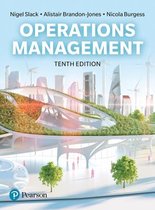Operations Management: Class Notes & Book Notes
Tilburg University: A complete summary of the Operations Management course.
This summery includes information given in the lectures, enhanced with information
from the book. Al lot of visuals have been used to underline and illustrate the
information understandably and clearly.
Parts of the book have been included as well:
Operations Management
Nigel Slack, Alistair Brandon-Jones
Publishing year april 2019
ISBN: 9781292253961
Edition: 9
1
,Lecture 1: Operations management & Processes
Operations management is the activity of managing the resources which are devoted
to the production and delivery of products and services. → all operations are input
transformation-output processes → every process is a transformation
Transformed Resources → materials, info, customers
Transforming Resources → machines, staff
Transformation Processes → ads, distribution etc.
Characteristics of goods/products
- Tangible
- Production proceeds consumption - they can be stored
- Transformed resources – materials Characteristics of services
- Intangible
- Production at the same time as consumption - cannot be stored
- Transformed resources – the customers
Spectrum of products and services
Neither pure products nor services exist. Operation of selling and
delivering still exists.
Facilitating Products: products that are produced by an operation to support its services
Facilitating Services: services produced by an operation to support its products
Process is an arrangement of resources and activities that transform input into outputs
that satisfy customer needs.
They are building blocks of all operations and they form an internal network within an
operation.
Operation Processes can be analyzed at three levels
1. flow between operations → level of the supply network
e.g. Analysis of Ben &Jerry’s suppliers for all ice-cream flavors, and suppliers of
Ben & Jerry’s ice-creams to customers
2. flow between processes → level of the operation
2
, Analysis of the activities in the Ben & Jerry’s production plants: processing, mixing
ingredients, freezing and packaging, product development, order processing,
inventory management
3. flow between resources → level of the process
e.g. mixing process: call up specifications, check availability of ingredients, work on
production line, test, hand over to packaging
4
Volume: level / rate of output
Variety: Range of output, different
products / services
Variation: degree to which rate/level
of output varies
Visibility: amount of value added that
takes place (in front of customer)
low high
volume High repeatability
low repetition
specialization capital
each staff member has multiple tasks
intensive low unit
less systematization high unit costs
costs
Variety well defined flexible
routine complex
standardized match customer needs high
regular low unit costs
unit costs
Variatio n stable / routine changing capacity / flexibility
predictable high anticipation in touch with
utilization low demand high unit cost
unit costs
Visibility time lag between consumption & short waiting tolerance
production standardization satisfaction governed by customer perception
centralization low contact skills low received variety is high customer contact skills
unit costs needed high unit cost
3
, Lecture 2: Operations performance
- three levels of operations performance
1.Societal Level: Operations Sustainability
corporate social responsibility (CSR)
→ triple bottom line
- People: The social account, measured by the impact of the operation on the
quality of people’s lives
- Planet: The environmental account, measured by environmental impact of the
operation
- Profit:The economic account, measured by profitability, return on assets, etc of
the operation.
Planet:
•Recyclability of materials, energy consumption, waste material generation
•Reducing transport-related energy
•Noise pollution, fume and emission pollution
•Obsolescence and wastage
•Environmental impact of process failures
•Recovery to minimize impact of failures
People:
•Customer safety from products and services
•Employment impact of an operation’s location
•Employment implications of outsourcing
•Repetitive or alienating work
•Staff safety and workplace stress
•Non-exploitation of developing country suppliers
Profit:
•Cost of producing products and services
•Revenue from the effects of quality, speed, dependability, and flexibility
•Effectiveness of investment in operations resources
•Risk and resilience of supply
•Building capabilities for the future
4






